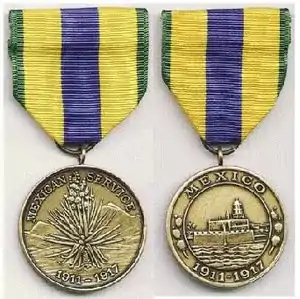United States involvement in the Mexican Revolution
The United States involvement in the Mexican Revolution was varied and seemingly contradictory, first supporting and then repudiating Mexican regimes during the period 1910–1920.[1] For both economic and political reasons, the U.S. government generally supported those who occupied the seats of power, but could withhold official recognition. The U.S. supported the regime of Porfirio Díaz (1876–1880; 1884–1911) after initially withholding recognition since he came to power by coup. In 1909, Díaz and U.S. President Taft met in Ciudad Juárez, across the border from El Paso, Texas. Prior to Woodrow Wilson's inauguration on March 4, 1913, the U.S. Government focused on just warning the Mexican military that decisive action from the U.S. military would take place if lives and property of U.S. nationals living in the country were endangered.[2] President William Howard Taft sent more troops to the US-Mexico border but did not allow them to intervene directly in the conflict,[3][4] a move which Congress opposed.[4] Twice during the Revolution, the U.S. sent troops into Mexico, to occupy Veracruz in 1914 and to northern Mexico in 1916 in a failed attempt to capture Pancho Villa. Although U.S. foreign policy toward Latin America was to assume the region was the sphere of influence of the U.S., articulated in the Monroe Doctrine and in Theodore Roosevelt's corollary to the Monroe Doctrine, which asserted the right of the U.S. to intervene militarily in the region to restore order if in the U.S. view a nation could not or would not do it itself, the U.S. role in the Mexican Revolution has been exaggerated. It did not directly intervene in the Mexican Revolution in a sustained manner.[5]
| United States involvement in the Mexican Revolution | |||||
|---|---|---|---|---|---|
| Part of the Mexican Revolution | |||||
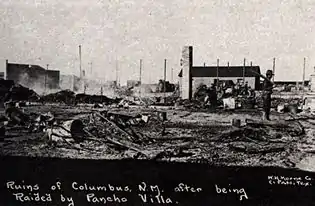 Aftermath of Pancho Villa's attack on Columbus, New Mexico, in 1916 | |||||
| |||||
| Belligerents | |||||
|
|
Maderistas Huertistas Villistas Constitutionalistas Carrancistas | ||||
| Commanders and leaders | |||||
|
|
Francisco Madero Victoriano Huerta Pancho Villa Venustiano Carranza Alvaro Obregon | ||||
During Díaz's long rule of Mexico, he implemented liberal policies aimed at modernization and economic development, inviting foreign entrepreneurs to invest in Mexico. The regime imposed political order and passed laws favorable to investors. American business interests invested large amounts of capital, particularly along the U.S.-Mexico border, during the decades of Díaz's rule. There was close economic cooperation between the two countries, which was predicated on Mexico's political stability. In 1908 Díaz gave an interview to a U.S. journalist, James Creelman, in which Díaz stated he would not run for re-election in 1910; the statement gave rise to politicking of potential candidates. Díaz reversed himself, ran for re-election, and jailed the leading opposition candidate, Francisco I. Madero. Mexican revolutionaries prior to the 1910 events had sought refuge on the U.S. side of the border, a pattern Madero continued. He escaped Mexico and took refuge in San Antonio, Texas, and called for nullification of the 1910 elections, himself as provisional president, and revolutionary support from the Mexican people. His Plan of San Luis Potosí did spark some revolutionary uprisings, particularly in Mexico's north. The U.S. stayed out of the unfolding events until March 6, 1911, when President William Howard Taft mobilized forces on the U.S.-Mexico border. "In effect this was an intervention in Mexican politics, and to Mexicans it meant the United States had condemned Díaz."[6]
When Díaz was forced to resign in 1911 and Francisco I. Madero was elected president in October 1911, U.S. president Taft was a lame duck, having lost the presidential election of 1912. He would remain in office until the March 1913 inauguration of Woodrow Wilson and during that interval, Taft's Ambassador to Mexico, Henry Lane Wilson actively sought to oust democratically elected Mexican president Madero. Lane Wilson was initially sympathetic to the Madero regime, but quickly came into conflict with it and conspired with General Victoriano Huerta to oust Madero. The anti-Madero coup took place in February 1913, known as the Ten Tragic Days, which saw the forced resignations of Madero and his vice president, followed immediately by their murders. The United States government under newly inaugurated president Woodrow Wilson refused to recognize Huerta's government.
Under President Wilson, the United States had sent troops to occupy Veracruz, with the dispute defused through a peace conference in Canada. Anti-Huerta forces in the north under Venustiano Carranza and in the south under Emiliano Zapata forced the resignation of Huerta in July 1914. A civil war of the winners broke out in 1915, with the U.S. recognizing Carranza's Constitutionalist faction, which allowed arms to flow to his army. Former Carranza ally, Pancho Villa was angered by the U.S. recognition of his rival and attacked the border town of Columbus, New Mexico in 1916. The U.S. Army under Gen. John J. Pershing pursued him in a punitive mission, known as the Pancho Villa Expedition. The U.S. failed in the main objective of that raid, which was to capture Villa. Carranza forced the U.S. to withdraw across the border.
| A graphical timeline is available at Timeline of the Mexican Revolution |
Diplomatic relations in the Díaz era
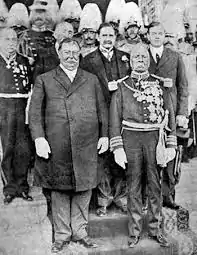
Díaz opened Mexico to foreign investment of Britain, France, Germany, and most especially the United States, creating the conditions of "order and progress" that promoted Mexico's modernization. Mexico-United States relations during Díaz's presidency were generally strong, although he began to strengthen ties with Great Britain, Germany, and France to offset U.S. power and influence.[7] U.S. President William Howard Taft recognized the role that Díaz played in transforming Mexico, saying "Certainly no people have made greater relative progress than the Mexican people have made under the administration of Porfirio Díaz...[he] has done more for the people of Mexico than any other Latin American has done for any of his people; ...the truth is they need a firm hand in Mexico and everybody realizes it."[8] Mexico was extremely important to U.S. business interests and Taft saw Díaz as key to protecting those investments. Taft met Díaz in person on the U.S.-Mexico border in 1909, an historic event in itself since it was the first trip of a sitting U.S. president to Mexico. It was a way for the U.S. to signal its continuing support of Díaz, despite his advancing age. Taft was pragmatic, saying "we have two billions American capital in Mexico that will be greatly endangered if Díaz were to die and his government go to pieces."[9]
Despite the importance of Mexico to U.S. business interests and the long border between the two countries that could make the U.S. vulnerable to unrest in Mexico having repercussions in the U.S., the U.S. had "a history of incompetent diplomatic representation." According to one scholar, the Taft administration's appointment of Henry Lane Wilson as ambassador "continued the tradition of incompetence."[9]
During the presidency of Porfirio Díaz, documents conveyed from the U.S. Consulate in Mexico kept the Secretary of State in Washington, D.C. informed about Mexican affairs. The Secretary of State told President Taft of the buildup to possible regime change in Mexico, when Díaz was unable to control rebellions in various areas of Mexico. Initially, Taft did not want to intervene but wanted to keep the Díaz government in power to prevent problems with business relations between the two countries, such as the sales of oil between Mexico and the United States.
The U.S. and the overthrow of President Madero, 1912–1913
President Taft's Ambassador to Mexico H.L. Wilson helped to plot the February 1913 coup d'état, during the Ten Tragic Days (la decena trágica), which overthrew Francisco I. Madero. The Ambassador might have done this without the explicit approval of lame duck President Taft, who was due to leave office March 4, 1913 with the inauguration of Woodrow Wilson. Ambassador Wilson had secured the support of the foreign diplomatic corps in Mexico, especially the British, German, and French envoys, for the coup and lobbied for U.S. recognition of the new head of state, General Victoriano Huerta.
U.S. and Huerta regime 1913–1914
.jpg.webp)
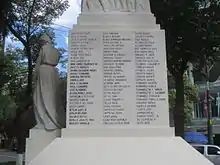
Woodrow Wilson was inaugurated president in March 1913, but the coup d'état in Mexico was an established fact, with the democratically elected president Madero murdered and his family in exile. President Wilson was horrified at the murders of President Madero and Vice President Pino Suárez and breaking from long-standing to recognize de facto regimes did not recognize the Huerta as the legitimate head of the Mexican government. Wilson refused to recognize the Huerta regime. From March to October 1913, Wilson pressured Huerta to resign, but did no seek other changes. Wilson urged the European powers to likewise not recognize the government. Huerta announced elections with himself as a candidate. In August 1913, Wilson recalled Ambassador Wilson to Washington and replaced him with John Lind and imposed an arms embargo on Huerta's regime, reversing his previous easy access to arms. In late August Huerta withdrew his name from consideration as a presidential candidate, and his foreign minister Federico Gamboa stood for election. The U.S. was enthusiastic about Gamboa's candidacy, which allowed it to support the new regime, but not Huerta himself. The U.S. pressured revolutionary opponents, including the newly emerged anti-Huerta leader Venustiano Carranza, to sign on to supporting a potential new Gamboa government. Carranza refused.[10]
A series of rebellions broke out in Mexico against Huerta's regime, especially in the North (Sonora, Chihuahua, and Coahuila), where the U.S. allowed arms sales to the revolutionaries. Fighting continued in Morelos under Emiliano Zapata, but the conflict there was a regional one with no U.S. involvement. Unlike the brief rebellions that helped bring Madero to power in 1910–1911, Mexico descended into civil war, with the U.S. backing revolutionary factions in the north. The involvement of the U.S. in larger conflicts with its diplomatic and economic rivals in Mexico, particularly Great Britain and Germany, meant that foreign powers affected the way the Mexican situation played out, even if they did not intervene militarily.[7]
When U.S. agents discovered that the German merchant ship, the Ypiranga, was carrying arms to Huerta's regime, President Wilson ordered troops to the port of Veracruz to stop the ship from docking. The U.S. did not declare war on Mexico but the U.S. troops carried out a skirmish against Huerta's forces in Veracruz. The Ypiranga managed to dock at another port, which infuriated Wilson.
On April 9, 1914, Mexican officials in the port of Tampico, Tamaulipas, arrested a group of U.S. sailors — including at least one taken from on board his ship, and thus from U.S. territory. After Mexico refused to apologize in the terms that the U.S. had demanded, the U.S. Navy bombarded the port of Veracruz and occupied Veracruz for seven months. Woodrow Wilson's actual motivation was his desire to overthrow Huerta, whom he refused to recognize as Mexico's leader;[11] the Tampico Affair did succeed in further destabilizing Huerta's regime and encouraging the revolutionary opponents. The ABC Powers (Argentina, Brazil, and Chile) arbitrated, in the Niagara Falls peace conference, held in Ontario, Canada, and U.S. troops left Mexican soil, averting an escalation of the conflict to war.
1916–1917
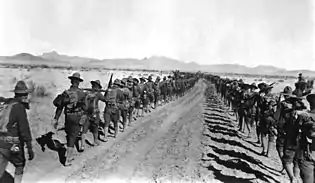
An increasing number of border incidents early in 1916 culminated in an invasion of American territory on 8 March 1916, when Francisco (Pancho) Villa and his band of 500 to 1,000 men raided Columbus, New Mexico, burning army barracks and robbing stores. In the United States, Villa came to represent mindless violence and banditry. Elements of the 13th Cavalry regiment repulsed the attack, but 14 soldiers and ten civilians were killed. Brig. Gen. John J. Pershing immediately organized a punitive expedition of about 10,000 soldiers to try to capture Villa. They spent 11 months (March 1916 – February 1917) unsuccessfully chasing him, though they did manage to destabilize his forces. A few of Villa's top commanders were also captured or killed during the expedition. The 7th, 10th, 11th, and 13th Cavalry regiments, 6th and U.S. 16th Infantry Regiments, part of the U.S. 6th Field Artillery, and supporting elements crossed the border into Mexico in mid-March, followed later by the 5th Cavalry, 17th and 24th Infantry Regiment (United States), and engineer and other units. Pershing was subject to orders which required him to respect the sovereignty of Mexico, and was further hindered by the fact that the Mexican government and people resented the invasion. Advance elements of the expedition penetrated as far as Parral, some 400 miles (640 km) south of the border, but Villa was never captured. The campaign consisted primarily of dozens of doughnut skirmishes with small bands of insurgents. There were even clashes with Mexican Army units; the most serious was on 21 June 1916 at the Battle of Carrizal, where a detachment of the 10th Cavalry was nearly destroyed. War would probably have been declared but for the critical situation in Europe. Even so, virtually the entire regular army was involved, and most of the National Guard had been federalized and concentrated on the border before the end of the affair. Normal relations with Mexico were restored eventually by diplomatic negotiation, and the troops were withdrawn from Mexico in February 1917.

Germany was a rival of the U.S. for influence in Mexico. As World War I raged in Europe, Germany was concerned that the U.S. would enter on the side of the British and French. Germany sought to tie down U.S. troops by fomenting war between the U.S. and Mexico. Germany sent a telegram in code outlining a plan to aid Mexico in such a conflict and Mexico's reward would be to regain land lost to the U.S. in the Mexican American War (1846-48). The Zimmermann Telegram was intercepted and decoded, then made public. Carranza, whose faction had benefited from U.S. support and then diplomatic recognition, was not drawn into the conflict. Mexico was neutral during World War I, which was a means for Mexico to carve out a role independent of the U.S. as well as the European powers.
The Constitutionalists who had won power in 1915-16 drafted a new constitution, adopted in February 1917. For foreign business interests the constitution was alarming, since it empowered the Mexican government to expropriate property deemed in the national interest and asserted rights to subsoil resources, which foreign petroleum companies saw as a direct threat to their interests. More radical elements of the revolution succeeded in having these provisions included, but Carranza did not implement them. U.S. business interests sought the support of the U.S. government against this threat to their enterprises, but Wilson did not act on their behalf.
1918–1919
Minor clashes with Mexican irregulars, as well as Mexican Federales, continued to disturb the U.S.-Mexican border from 1917 to 1919. Although the Zimmermann Telegram affair of January 1917 did not lead to a direct U.S. intervention, it took place against the backdrop of the Constitutional Convention and exacerbated tensions between the USA and Mexico. Military engagements took place near Buenavista, Sonora, on 1 December 1917; in San Bernardino Canyon, Chihuahua, on 26 December 1917; near La Grulla, Texas, on 9 January 1918; at Pilares, Mexico, about 28 March 1918; at the town of Nogales on the Sonora–Arizona border on 27 August 1918; and near El Paso, Texas, on 16 June 1919.
Foreign mercenaries in Mexico

Many adventurers, ideologues and freebooters from outside Mexico were attracted by the purported excitement and romance of the Mexican Revolution. Most mercenaries served in armies operating in the north of Mexico, partly because those areas were the closest to popular entry points to Mexico from the U.S., and partly because Pancho Villa had no compunction about hiring mercenaries. The first legion of foreign mercenaries, during the 1910 Madero revolt, was the Falange de los Extranjeros (Foreign Phalanx), which included Giuseppe ("Peppino") Garibaldi, grandson of the famed Italian unifier, as well as many American recruits.
Later, during the revolt against the coup d'état of Victoriano Huerta, many of the same foreigners and others were recruited and enlisted by Pancho Villa and his División del Norte. Villa recruited Americans, Canadians and other foreigners of all ranks from simple infantrymen on up, but the most highly prized and best paid were machine gun experts such as Sam Dreben, artillery experts such as Ivor Thord-Gray, and doctors for Villa's celebrated Servicio sanitario medic and mobile hospital corps. There is little doubt that Villa's Mexican equivalent of the French Foreign Legion (known as the "Legion of Honor") was an important factor in Villa's successes against Huerta's Federal Army.
U.S. military decorations
The U.S. military awarded the Mexican Service Medal to its troops for service in Mexico. The streamer is yellow with a blue center stripe and a narrow green stripe on each edge. The green and yellow recalls the Aztec standard carried at the Battle of Otumba in 1520, which carried a gold sun surrounded by the green plumes of the quetzal. The blue color alludes to the United States Army and refers to the Rio Grande separating Mexico from the United States.
See also
- Mexican Revolution
- Mexico-United States relations
Gallery
 Mexico's fruitless pursuit of progress, where "lots of energy [is] expended but [there is]…no discernible forward progress."[12] It suggests that until Mexico willingly forgoes violence (the pistol) and anarchy (the torch), they will remain stagnant. (San Francisco Examiner 1913)
Mexico's fruitless pursuit of progress, where "lots of energy [is] expended but [there is]…no discernible forward progress."[12] It suggests that until Mexico willingly forgoes violence (the pistol) and anarchy (the torch), they will remain stagnant. (San Francisco Examiner 1913)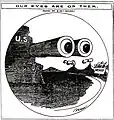 The United States are ever watchful over the presumed chaos in Mexico[13] (Chicago Tribune 1913)
The United States are ever watchful over the presumed chaos in Mexico[13] (Chicago Tribune 1913)
References
- Friedrich Katz, The Secret War in Mexico: Europe, the United States, and the Mexican Revolution. Chicago: University of Chicago Press 1981, p. 563.
- http://www.angelfire.com/rebellion2/projectmexico/2.html
- http://www.presidentprofiles.com/Grant-Eisenhower/William-Howard-Taft-Foreign-affairs.html
- http://millercenter.org/president/taft/essays/biography/5
- Knight, Alan. "The U.S. and the Mexican Peasantry, c. 1880–1940" in Daniel Nugent, ed. Rural Revolt in Mexico and U.S. Intervention. La Jolla: Center for U.S.-Mexican Studies, University of California, San Diego 1988, p. 31.
- Womack, John. "The Mexican Revolution" in Mexico Since Independence, ed. Leslie Bethell. Cambridge: Cambridge University Press 1991, p. 131.
- Katz, The Secret War in Mexico.
- quoted in Lars Schoultz, Beneath the United States: A History of U.S. Policy Toward Latin America. Cambridge: Harvard University Press 1998, pp. 237-38.
- Schoultz, Beneath the United States, p. 238.
- Katz, The Secret War in Mexico, pp. 167-69.
- http://militaryhistory.about.com/od/battleswars1900s/p/veracruz.htm
- Anderson, Mark. C. "What's to Be Done With 'Em? Images of Mexican Cultural Backwardness, Racial Limitations and Moral Decrepitude in the United States Press 1913–1915", Mexican Studies, Winter Vol. 14, No. 1 (1998):30-31.
- Anderson, Mark. C. "What's to Be Done With 'Em? Images of Mexican Cultural Backwardness, Racial Limitations and Moral Decrepitude in the United States Press 1913–1915", Mexican Studies, Winter Vol. 14, No. 1 (1998):40-41.
Further reading
- Anderson, Mark. C. “What’s to Be Done With ‘Em? Images of Mexican Cultural Backwardness, Racial Limitations and Moral Decrepitude in the United States Press 1913–1915”, Mexican Studies, Winter Vol. 14, No. 1 (1998): 23-70.
- Britton, John. A. Revolution and Ideology: Images of the Mexican Revolution in the United States. Kentucky: The University Press of Kentucky (1995)
- Hart, John Mason. Empire and Revolution: The Americans in Mexico Since the Civil War. Berkeley: University of California Press 2002.
- Katz, Friedrich. The Secret War in Mexico: Europe, the United States, and the Mexican Revolution. Chicago: University of Chicago Press 1981.
- Knight, Alan. The Mexican Revolution. (2 vols). Cambridge: Cambridge University Press 1986.
- Nugent, Daniel, ed. Rural Revolt in Mexico and U.S. Intervention. LaJolla, CA: Center for U.S.-Mexican Studies, University of California, San Diego 1988.
- Womack, John. "The Mexican Revolution" in Mexico Since Independence, ed. Leslie Bethell. Cambridge: Cambridge University Press 1991,
